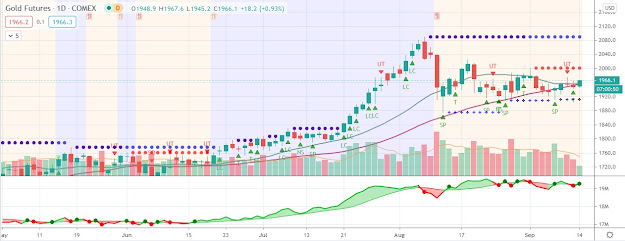Gold price fell $12.07, or 0.7%, to $1,630.55 per ounce
The gold price fell $12.07, or 0.7%, to $1,630.55 per ounce Monday morning amid widespread liquidation in financial markets and strength in the U.S. dollar. Silver fared worse than the price of gold, as it dropped $0.87, or 2.8%, to $30.81 per ounce. In doing so, the prices of gold and silver reached their lowest levels since April 4th and January 20th, respectively.
Commenting on the gold sector’s weakness of late, analysts at UBS wrote in recent notes to clients that “Physical demand is currently underwhelming – barely even blinking when prices dipped below $1640 yesterday – and this hardly offers any assurance that gold can easily find support on any further price drops… Gold could certainly use fresh catalysts from external markets at this stage to shake it out of this stupor.”
One potential catalyst for the yellow metal that surfaced last week was from John Paulson, the billionaire hedge fund magnate whose firm – Paulson & Co. – is the largest shareholder in the SPDR Gold Trust (GLD). Paulson told investors that he recently transferred some of his own capital out of his firm’s Credit Opportunities Fund and moved it into the Paulson Gold Fund to take advantage of the sector’s weakness.
UBS later stated in its report that “Until there is a clear sign as to whether it is taking on a safe-haven or a risk persona, investors are likely to continue keeping participation small and timelines brief. Instead, it’s quite likely that gold will wait and take its next directional cue from the FOMC (Federal Open Market Committee) meeting next week.”
As the firm alluded to, the Federal Reserve’s next monetary policy meeting will occur on Wednesday April 25th. There, the Ben Bernanke-led Federal Reserve is expected to maintain but not add to its current slate of accommodative policies. However, investors will be keeping a close eye on the language and tone of the FOMC meeting for any hints on a potential third round of quantitative easing (QE3).
At last month’s Fed meeting, the central bank exhibited a less dovish stance than most investors were expecting – which helped pressure the price of gold in the days that followed. However, several economists still expect the Fed to launch further accommodative measures by the June FOMC meeting. One individual in this camp is Jan Hatzius, chief U.S. economist at Goldman Sachs. Hatzius recently stated that the firm’s “baseline” scenario is that “we will see something in the second quarter” with regard to additional Fed easing.
Chairman Bernanke and his fellow central bankers are “encouraged by the improvements in the labor market they’ve seen but they want to keep them going,” the Goldman Sachs economist added. “And they’re concerned if the economy doesn’t accelerate and GDP growth doesn’t pick up from here, that maybe we’ll see a slowdown in the pace of those gains.”
Commenting on the gold sector’s weakness of late, analysts at UBS wrote in recent notes to clients that “Physical demand is currently underwhelming – barely even blinking when prices dipped below $1640 yesterday – and this hardly offers any assurance that gold can easily find support on any further price drops… Gold could certainly use fresh catalysts from external markets at this stage to shake it out of this stupor.”
One potential catalyst for the yellow metal that surfaced last week was from John Paulson, the billionaire hedge fund magnate whose firm – Paulson & Co. – is the largest shareholder in the SPDR Gold Trust (GLD). Paulson told investors that he recently transferred some of his own capital out of his firm’s Credit Opportunities Fund and moved it into the Paulson Gold Fund to take advantage of the sector’s weakness.
UBS later stated in its report that “Until there is a clear sign as to whether it is taking on a safe-haven or a risk persona, investors are likely to continue keeping participation small and timelines brief. Instead, it’s quite likely that gold will wait and take its next directional cue from the FOMC (Federal Open Market Committee) meeting next week.”
As the firm alluded to, the Federal Reserve’s next monetary policy meeting will occur on Wednesday April 25th. There, the Ben Bernanke-led Federal Reserve is expected to maintain but not add to its current slate of accommodative policies. However, investors will be keeping a close eye on the language and tone of the FOMC meeting for any hints on a potential third round of quantitative easing (QE3).
At last month’s Fed meeting, the central bank exhibited a less dovish stance than most investors were expecting – which helped pressure the price of gold in the days that followed. However, several economists still expect the Fed to launch further accommodative measures by the June FOMC meeting. One individual in this camp is Jan Hatzius, chief U.S. economist at Goldman Sachs. Hatzius recently stated that the firm’s “baseline” scenario is that “we will see something in the second quarter” with regard to additional Fed easing.
Chairman Bernanke and his fellow central bankers are “encouraged by the improvements in the labor market they’ve seen but they want to keep them going,” the Goldman Sachs economist added. “And they’re concerned if the economy doesn’t accelerate and GDP growth doesn’t pick up from here, that maybe we’ll see a slowdown in the pace of those gains.”




Comments
Post a Comment